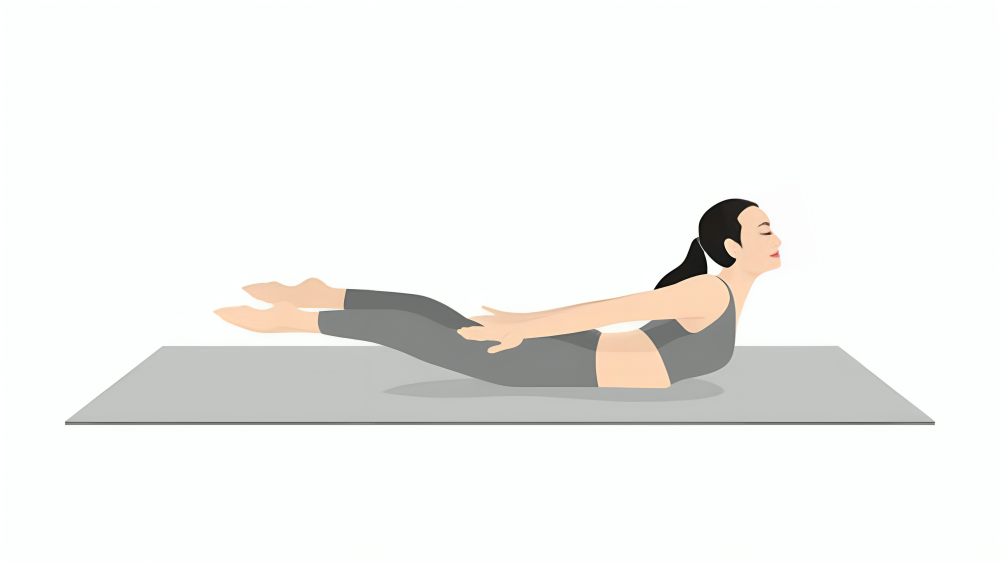
What is Salabhasana?
Salabhasana, pronounced “sah-lah-BAH-sah-nah,” comes from the Sanskrit words “Salabha,” meaning locust, and “Asana,” meaning pose. True to its name, the pose resembles a locust or a grasshopper with its legs lifted and body extended, symbolizing strength and resilience. This pose is mainly focused on strengthening the back muscles, enhancing spinal flexibility, and opening the chest.
How to Do Salabhasana: Step-by-Step Guide
Getting Started: Prepare Your Space
Before you start, find a quiet space with enough room to stretch out fully. Lay down a yoga mat to ensure a comfortable base and prevent slipping.
Begin by Lying Down
Lie face down on your yoga mat, with your arms resting alongside your body and palms facing upwards. Keep your legs straight and together, with your forehead gently resting on the mat.
Engage Your Core and Lift
Take a deep breath in. As you exhale, engage your core muscles and lift your head, chest, and legs off the ground simultaneously. Your arms should remain by your sides, palms facing the floor but not touching it.
Hold the Pose
Keep your gaze forward or slightly upward, ensuring that your neck stays in a neutral position, not strained. Hold this pose for about 10 to 30 seconds, depending on your comfort level. Focus on using your back muscles rather than your arms to keep yourself lifted.
Release and Relax
As you exhale, gently lower your chest, head, and legs back to the mat. Turn your head to one side and rest for a few breaths before repeating the pose if desired.
Repeat for Best Results
For beginners, repeating Salabhasana 2-3 times is sufficient. As you build strength, you can gradually increase the duration and the number of repetitions.
Benefits of Salabhasana
Strengthens the Back Muscles
This pose targets the muscles along the spine, including the lower back, upper back, and shoulders. Regular practice helps build strength in these areas, which can alleviate back pain and improve posture.
Improves Flexibility and Mobility
By lifting the chest and legs, Salabhasana stretches the front body and enhances flexibility in the spine and hips. Over time, this can lead to improved overall mobility and reduce stiffness.
Stimulates the Digestive System
The gentle pressure exerted on the abdomen while performing this pose stimulates digestive organs, improving digestion and helping to relieve constipation.
Enhances Core Strength
Though the primary focus is on the back muscles, Salabhasana also engages the core. This engagement helps in toning the abdominal muscles and improving overall core strength.
Boosts Circulation
Lifting the chest and legs encourages blood flow throughout the body, promoting better circulation and helping to reduce fatigue.
Relieves Stress and Anxiety
Like many yoga poses, Salabhasana requires concentration and controlled breathing, which can help calm the mind and reduce stress and anxiety levels.
Helps Improve Posture
By strengthening the back muscles and improving spinal flexibility, Salabhasana can help correct poor posture, reducing the risk of developing a hunched back.
It’s here Bhujangasana How to do it and what are the Benefits
FAQs
Q: Can beginners do Salabhasana?
A: Absolutely! Salabhasana is beginner-friendly. Start slowly, listen to your body, and gradually increase the intensity as you become more comfortable.
Q: How often should I practice Salabhasana?
A: You can practice Salabhasana as part of your regular yoga routine, ideally 3-4 times a week. Consistent practice will yield the best results.
Q: Can Salabhasana help with back pain?
A: Yes, Salabhasana strengthens the back muscles and improves spinal flexibility, which can help alleviate back pain over time. However, if you have severe back pain or any injuries, consult a healthcare professional before practicing.
Q: What if I can’t lift my legs very high?
A: No worries! Lifting your legs just a few inches off the ground is perfectly fine, especially when starting. Focus on engaging your back muscles and breathing steadily, and you’ll see improvement with practice.

